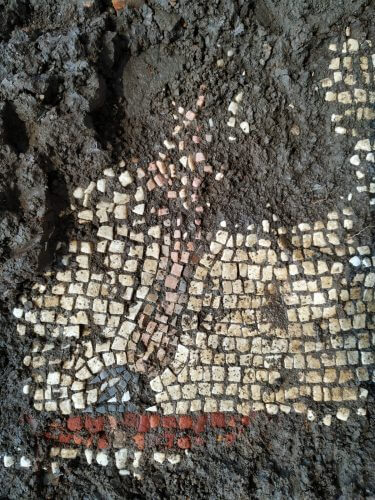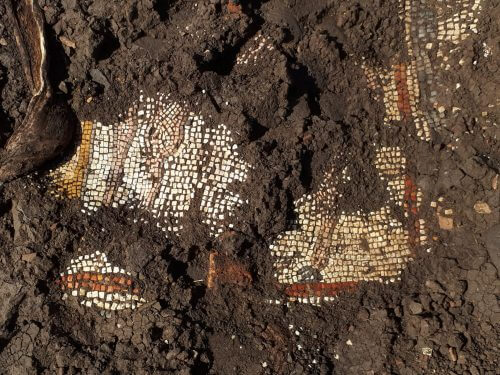For the first time in the Golan, a synagogue from the Roman period was uncovered with a rare mosaic that sheds light on the decoration of synagogues in the third century.

Fragments of a mosaic in which drawings of animal feet remain were discovered in the excavation of a synagogue in the ancient settlement of Majdolya in the Golan, which apparently began at the end of the Second Temple period, in the first century and ceased to exist at the end of the third century, and it shows the change that took place in the Jewish community during the Roman period, so The findings of the last excavation season at the site are emerging. "This is the earliest evidence of a colorful and decorated mosaic in a synagogue in the Golan and it dates to the third century AD, a period for which there is almost no information about the Jewish settlement in the Golan in particular and few remains of synagogues in the country in general. In the third century AD we see an interesting combination of the continuation of the tradition of synagogues from the time of the Second Temple, for example in the form of the yeshiva and the relatively unadorned architectural tradition with the addition of new elements that over time will become common in synagogues, such as a colorful mosaic that includes animals," said Dr. Michael Azband From the Zinman Institute of Archeology at the University of Haifa, director of the excavation.
In recent years, an excavation expedition led by Dr. Ezband from the University of Haifa, in collaboration with Dr. Benny Arobs from the Institute of Archeology at the Hebrew University, has been excavating in the ancient settlement of Majdolya, next to the settlement of Netor in the Golan. The site dates mainly to the Roman period, from the middle of the first century AD until the abandonment of the settlement, apparently, at the end of the third century. Several years ago, the researchers found the remains of a synagogue in a place with a rectangular plan measuring 13 x 23 m. Finding the remains of the synagogue was of enormous importance: until a few years ago, the prevailing view in research was that the Jewish settlement in the Golan ceased to exist after the Great Revolt with the destruction of Gamla in 67 CE. The finding of the synagogue together with a few similar testimonies from additional excavations and surveys in recent years strengthened the understanding that the Jewish settlement continued to exist. The last excavation season at the synagogue added a new and important layer to the understanding of the development of Jewish life over the years and life in the countryside during the Roman period in the Golan.
Inside the synagogue, the researchers were able to uncover colorful mosaic sections. The structure was revealed with the assistance of Mr. Shalom Ariel who joined the project as part of his master's degree in Land of Israel Studies at Kinneret College and without whose dedication and patience it is doubtful whether the investigation of the structure in general and the mosaic in particular would have been advanced to their current state. According to Dr. Azband, the fact that the settlement was abandoned at the end of the third century allowed the researchers to more accurately date the finds, but it also meant that they were almost never preserved: only the lower tiers of the synagogue survived and only a few sections of the mosaic remained, apparently due to intentional dismantling along the length the periods. The uncovered mosaic sections indicate that the floor of the citrates (side halls) was colorful and characterized by a wealth of geometric patterns. The mosaic in the middle hall, the central hall, turned out to be more complex and richer, and despite its poor state of preservation, it is possible to identify animal feet - bird feet and other unidentified animal feet.

According to the researchers, the design richness of the mosaic and especially the fact that it is decorated with figures of animals has an important meaning: according to the hypothesis, this is evidence that the synagogue changed from a place dedicated almost exclusively for the purpose of study to a place that becomes the center of prayer for the community. "We know that synagogues at the end of the Second Temple period were mainly used as a place of Torah study. Synagogues at the end of the Roman period and especially during the Byzantine period are used as a place of prayer, a kind of 'little temple' and therefore they are much more luxurious and it is not uncommon that they also include fancy mosaics. Our findings are among the earliest found so far, which indicate that already in the third century the synagogues began to undergo this important change in consciousness," concluded Dr. Azband.
Many volunteers from the residents of the region and abroad are taking part in the excavations, with assistance from the Golan Regional Council, the Shamir Institute for Research, and support from the National Science Foundation. To all those who take part in the work, I extend a warm greeting and a heartfelt thank you. We will also note that the main mosaic sections were removed for thorough conservation treatment. The work was carried out by the security guard Victor Uziel.
